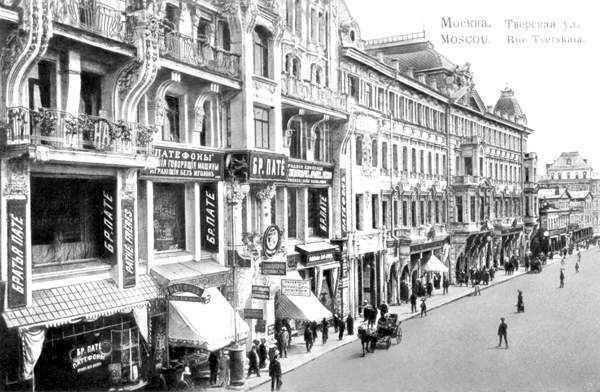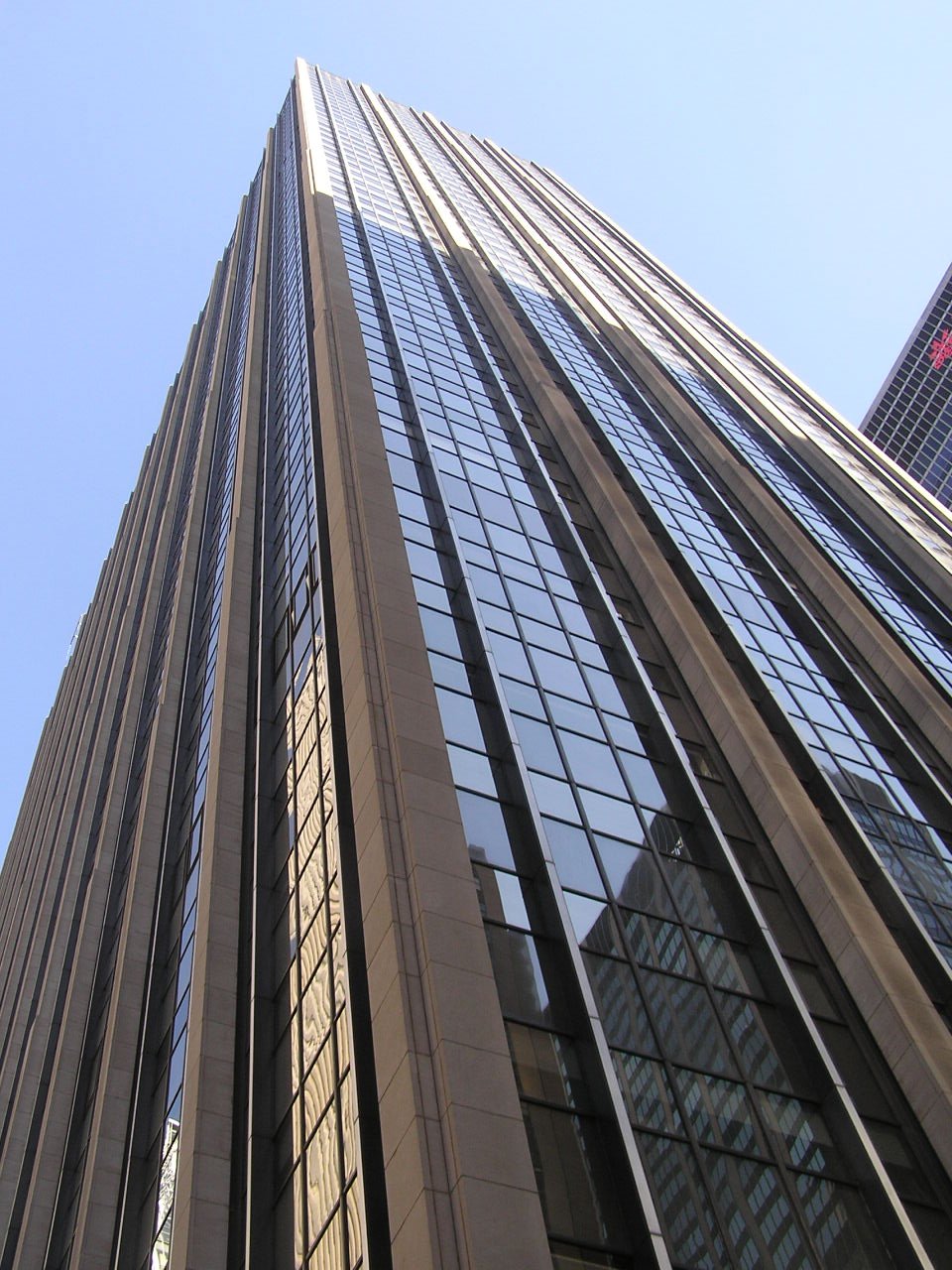|
Tverskaya Street
Tverskaya Street ( rus, –Ę–≤–Ķ—Ä—Ā–ļ–į—Ź —É–Ľ–ł—Ü–į, p=tv ≤…™rňąskaj…ô ňąul ≤…™tÕ°s…ô), known between 1935 and 1990 as Gorky Street (russian: —É–Ľ–ł—Ü–į –ď–ĺ—Ä—Ć–ļ–ĺ–≥–ĺ), is the main radial street in Moscow. The street runs Northwest from the central Manege Square in the direction of Saint Petersburg and terminates at the Garden Ring, giving the name to Tverskoy District. The route continues further as First Tverskaya-Yamskaya Street, Leningradsky Avenue and Leningradskoye Highway. History and architecture Middle Ages to 18th century Tourists are told that Tverskaya Street existed as early as the 12th century. Its importance for the medieval city was immense, as it connected Moscow with its superior, and later chief rival, Tver. At that time, the thoroughfare crossed the Neglinnaya River. The first stone bridge across the Neglinnaya was set up in 1595. In the 17th and 18th centuries, Tverskaya Street was renowned as the centre of Moscow's social life. The nobility co ... [...More Info...] [...Related Items...] OR: [Wikipedia] [Google] [Baidu] |
State Historical Museum
The State Historical Museum ( Russian: –ď–ĺ—Ā—É–ī–į—Ä—Ā—ā–≤–Ķ–Ĺ–Ĺ—č–Ļ –ł—Ā—ā–ĺ—Ä–ł—á–Ķ—Ā–ļ–ł–Ļ –ľ—É–∑–Ķ–Ļ, ''Gosudarstvenny istoricheskiy muzyey'') of Russia is a museum of Russian history The history of Russia begins with the histories of the East Slavs. The traditional start-date of specifically Russian history is the establishment of the Rus' state in the north in 862, ruled by Varangians. Staraya Ladoga and Novgorod became ... located between Red Square and Manezhnaya Square, Moscow, Manege Square in Moscow. The museum's exhibitions range from relics of prehistoric tribes that lived in the territory of present-day Russia, to priceless artworks acquired by members of the Romanov dynasty. The total number of objects in the museum's collection numbers in the millions. Description The place where the museum now stands was formerly occupied by the Principal Medicine Store, built by order of Peter I of Russia, Peter the Great in the Moscow baroque style. The museum was f ... [...More Info...] [...Related Items...] OR: [Wikipedia] [Google] [Baidu] |
Leningradsky Avenue
Leningradsky Prospekt (russian: –õ–Ķ–Ĺ–ł–Ĺ–≥—Ä–įŐĀ–ī—Ā–ļ–ł–Ļ –Ņ—Ä–ĺ—Ā–Ņ–ĶŐĀ–ļ—ā), or Leningrad Avenue, is a major arterial avenue in Moscow, Russia. It continues the path of Tverskaya Street and 1st Tverskaya-Yamskaya Street north-west from Belorussky Rail Terminal, and changes the name once again to Leningrad Highway past the Sokol metro station. The Highway continues its way to Saint Petersburg via Tver (not unlike Moskovsky Prospekt in Saint Petersburg, which is named after, and leads to, Moscow). Until 1957, Leningradsky Prospekt was part of Leningrad Highway (Petersburg Highway prior to 1924). Both avenues retain their Lenin-related names after the reinstatement of the historical Saint Petersburg name. History The old road to Tver, changing its course over Middle Ages, settled in its present site in the 16th century. The name ''Peterburskoye Schosse'' (Highway) was established when the road was properly paved between 1786 and 1790. The most important historical building ... [...More Info...] [...Related Items...] OR: [Wikipedia] [Google] [Baidu] |
Pushkin
Alexander Sergeyevich Pushkin (; rus, links=no, –ź–Ľ–Ķ–ļ—Ā–į–Ĺ–ī—Ä –°–Ķ—Ä–≥–Ķ–Ķ–≤–ł—á –ü—É—ą–ļ–ł–ĹIn pre-Revolutionary script, his name was written ., r=Aleksandr Sergeyevich Pushkin, p=…źl ≤…™kňąsandr s ≤…™rňą…° ≤e(j)…™v ≤…™t…ē ňąpu āk ≤…™n, a=ru-Pushkin.ogg; ) was a Russian poet, playwright, and novelist of the Romantic era.Basker, Michael. Pushkin and Romanticism. In Ferber, Michael, ed., ''A Companion to European Romanticism''. Oxford: Blackwell, 2005. He is considered by many to be the greatest Russian poetShort biography from University of Virginia . Retrieved 24 November 2006.Allan Rei ... [...More Info...] [...Related Items...] OR: [Wikipedia] [Google] [Baidu] |
Yury Dolgoruky
Yuri I Vladimirovich ( rus, –ģ—Ä–ł–Ļ –í–Ľ–į–ī–ł–ľ–ł—Ä–ĺ–≤–ł—á, Yuriy Vladimirovich), commonly known as Yuri Dolgorukiy or the Long Arm ( rus, –ģ—Ä–ł–Ļ –Ē–ĺ–Ľ–≥–ĺ—Ä—É–ļ–ł–Ļ, Yuriy Dolgorukiy, meaning "Far-Reaching", c. 109915 May 1157) was a Rurikid prince. Noted for successfully curbing the privileges of the landowning ''boyar'' class in Rostov-Suzdal and his ambitious building programme, Yuri transformed this principality into the independent power that would evolve into early modern Muscovy. Yuri spent much of his life in internecine strife with the other Rurikid princes for suzerainty over the Kievan Rus, which had been held by his father (Vladimir Monomakh) and his elder brother before him. Although he twice managed to hold Kiev (in September 1149 - April 1151, again in March 1155 - May 1157) and rule as Grand Prince of all Rus', his autocratic rule and perceived foreigner status made him unpopular with the powerful Kievan ''boyars,'' leading to his presumed poisoning and ... [...More Info...] [...Related Items...] OR: [Wikipedia] [Google] [Baidu] |
Tverskaya Square
{{Disambiguation, geo ...
Tverskoy (masculine), Tverskaya (feminine), or Tverskoye (neuter) may refer to: * Tverskoy District, a district in Central Administrative Okrug of the federal city of Moscow, Russia *Tverskoy Boulevard, one of the main thoroughfares in central Moscow *Tver Oblast (''Tverskaya oblast''), a federal subject of Russia *Tverskaya Street, a street in Moscow, Russia *Tverskaya (Moscow Metro), a station on the Zamoskvoretskaya Line of the Moscow Metro, Moscow, Russia *Tverskoy, Russia (''Tverskaya'', ''Tverskoye''), several rural localities in Russia *Tverskoye, former name of Ňěirinb…ôyli, a village in Azerbaijan *Julia Tverskaya (born 1959), Moscow born American chess player See also *Tver Tver ( rus, –Ę–≤–Ķ—Ä—Ć, p=tv ≤er ≤) is a city and the administrative centre of Tver Oblast, Russia. It is northwest of Moscow. Population: Tver was formerly the capital of a powerful medieval state and a model provincial town in the Russian ... [...More Info...] [...Related Items...] OR: [Wikipedia] [Google] [Baidu] |
Triumphal Arch
A triumphal arch is a free-standing monumental structure in the shape of an archway with one or more arched passageways, often designed to span a road. In its simplest form a triumphal arch consists of two massive piers connected by an arch, crowned with a flat entablature or attic on which a statue might be mounted or which bears commemorative inscriptions. The main structure is often decorated with carvings, sculpted reliefs, and dedications. More elaborate triumphal arches may have multiple archways. Triumphal arches are one of the most influential and distinctive types of architecture associated with ancient Rome. Thought to have been invented by the Romans, the Roman triumphal arch was used to commemorate victorious generals or significant public events such as the founding of new colonies, the construction of a road or bridge, the death of a member of the imperial family or the ascension of a new emperor. The survival of great Roman triumphal arches such as the Arch of Ti ... [...More Info...] [...Related Items...] OR: [Wikipedia] [Google] [Baidu] |
Time Life
Time Life, with sister subsidiaries StarVista Live and Lifestyle Products Group, a holding of Direct Holdings Global LLC, is an American production company and direct marketer conglomerate, that is known for selling books, music, video/DVD, and multimedia products. The current focus of the group is music, video, and entertainment experiences (such as the StarVista cruises) as the Time Life book division closed in 2001. Its products have been sold throughout North America, Europe, Australia, and Asia through television, print, retail, the Internet, telemarketing, and direct sales. Current operations are focused in the US and Canada with limited retail distribution overseas. Overview Time Life was founded in 1961 as the book marketing division of Time, Incorporated. It took its name from Time Inc.'s cornerstone magazines, ''Time'' and ''Life'', two of the most popular magazines of the era, but remained independent from both. Starting in 1967, Time Life combined its book offe ... [...More Info...] [...Related Items...] OR: [Wikipedia] [Google] [Baidu] |
Yuri Dolgoruky
Yuri I Vladimirovich ( rus, –ģ—Ä–ł–Ļ –í–Ľ–į–ī–ł–ľ–ł—Ä–ĺ–≤–ł—á, Yuriy Vladimirovich), commonly known as Yuri Dolgorukiy or the Long Arm ( rus, –ģ—Ä–ł–Ļ –Ē–ĺ–Ľ–≥–ĺ—Ä—É–ļ–ł–Ļ, Yuriy Dolgorukiy, meaning "Far-Reaching", c. 109915 May 1157) was a Rurikid prince. Noted for successfully curbing the privileges of the landowning ''boyar'' class in Rostov-Suzdal and his ambitious building programme, Yuri transformed this principality into the independent power that would evolve into early modern Muscovy. Yuri spent much of his life in internecine strife with the other Rurikid princes for suzerainty over the Kievan Rus, which had been held by his father (Vladimir Monomakh) and his elder brother before him. Although he twice managed to hold Kiev (in September 1149 - April 1151, again in March 1155 - May 1157) and rule as Grand Prince of all Rus', his autocratic rule and perceived foreigner status made him unpopular with the powerful Kievan ''boyars,'' leading to his presumed poisoning an ... [...More Info...] [...Related Items...] OR: [Wikipedia] [Google] [Baidu] |
English Club
English usually refers to: * English language * English people English may also refer to: Peoples, culture, and language * ''English'', an adjective for something of, from, or related to England ** English national identity, an identity and common culture ** English language in England, a variant of the English language spoken in England * English languages (other) * English studies, the study of English language and literature * ''English'', an Amish term for non-Amish, regardless of ethnicity Individuals * English (surname), a list of notable people with the surname ''English'' * People with the given name ** English McConnell (1882‚Äď1928), Irish footballer ** English Fisher (1928‚Äď2011), American boxing coach ** English Gardner (b. 1992), American track and field sprinter Places United States * English, Indiana, a town * English, Kentucky, an unincorporated community * English, Brazoria County, Texas, an unincorporated community * Engli ... [...More Info...] [...Related Items...] OR: [Wikipedia] [Google] [Baidu] |
Catherine The Great
, en, Catherine Alexeievna Romanova, link=yes , house = , father = Christian August, Prince of Anhalt-Zerbst , mother = Joanna Elisabeth of Holstein-Gottorp , birth_date = , birth_name = Princess Sophie of Anhalt-Zerbst , birth_place = Stettin, Pomerania, Prussia, Holy Roman Empire(now Szczecin, Poland) , death_date = (aged 67) , death_place = Winter Palace, Saint Petersburg, Russian Empire , burial_date = , burial_place = Saints Peter and Paul Cathedral, Saint Petersburg , signature = Catherine The Great Signature.svg , religion = Catherine II (born Sophie of Anhalt-Zerbst; 2 May 172917 November 1796), most commonly known as Catherine the Great, was the reigning empress of Russia from 1762 to 1796. She came to power following the overthrow of her husband, Peter III. Under her long reign, inspired by the ideas of the Enlightenment, Russia experienced a renaissance of culture and sciences, which led to the founding of m ... [...More Info...] [...Related Items...] OR: [Wikipedia] [Google] [Baidu] |
Palladian
Palladian architecture is a European architectural style derived from the work of the Venetian architect Andrea Palladio (1508‚Äď1580). What is today recognised as Palladian architecture evolved from his concepts of symmetry, perspective and the principles of formal classical architecture from ancient Greek and Roman traditions. In the 17th and 18th centuries, Palladio's interpretation of this classical architecture developed into the style known as Palladianism. Palladianism emerged in England in the early 17th century, led by Inigo Jones, whose Queen's House at Greenwich has been described as the first English Palladian building. Its development faltered at the onset of the English Civil War. After the Stuart Restoration, the architectural landscape was dominated by the more flamboyant English Baroque. Palladianism returned to fashion after a reaction against the Baroque in the early 18th century, fuelled by the publication of a number of architectural books, including Pal ... [...More Info...] [...Related Items...] OR: [Wikipedia] [Google] [Baidu] |




.jpg)
